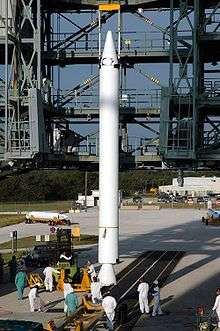Booster (rocketry)
A booster rocket (or engine) is either the first stage of a multistage launch vehicle, or else a shorter-burning rocket used in parallel with longer-burning sustainer rockets to augment the space vehicle's takeoff thrust and payload capability. (Boosters used in this way are frequently designated "zero stages".) Boosters are traditionally necessary to launch spacecraft into low Earth orbit (absent a single-stage-to-orbit design), and are certainly necessary for a space vehicle to go beyond Earth orbit. The booster is dropped to fall back to Earth once its fuel is expended, a point known as booster engine cut-off (BECO). The rest of the launch vehicle continues flight with its core or upper-stage engines. The booster may be recovered and reused, as in the case of the Space Shuttle.
Strap-on boosters are sometimes used to augment the payload or range capability of jet aircraft (usually military).
Drop-away engines
The SM-65 Atlas rocket used three engines, one of which was fixed to the fuel tank, and two of which were mounted on a skirt which dropped away at BECO. This was used as an Intercontinental ballistic missile (ICBM); to launch the manned Project Mercury capsule into orbit; and as the first stage of the Atlas-Agena and Atlas-Centaur launch vehicles.
Strap-on boosters
The Titan III, used by the United States Air Force as an unmanned heavy-lift vehicle, was developed from the Titan II launch vehicle by adding a pair of strap-on solid rocket boosters (SRB). It was also planned to be used for the Manned Orbital Laboratory program, which was cancelled in 1969.
NASA's Space Shuttle was the first manned vehicle to use solid-fueled boosters as strap-ons. The solid boosters consisted of stacked segments, and were recovered and reused multiple times.
Recoverable boosters
The booster casings for the Space Shuttle Solid Rocket Booster were recovered and refurbished for reuse from 1981–2011 as part of the Space Shuttle program.
In a new development program initiated in 2011, SpaceX developed technologies to facilitate the return, vertical landing, and recovery for low-cost and rapid reuse of a recoverable booster.[1] The program was intended to reduce launch prices significantly, opening new markets for the use of space.[2] A multi-year, multi-element test program was conducted in 2013–2016, with first successful return in 2015,[3] and multiple returns both on land[4] and landing platforms at sea some distance away from the launch site during 2016.[5]
Use in aviation
Rocket boosters used on aircraft are known as Jet-Assisted TakeOff (JATO) rockets.
Various missiles also use solid rocket boosters. Examples are:
- 2K11 (SA-4) which uses SRBs as a first stage, and then a ramjet.
- S-200 (SA-5) which uses SRBs as the first stage, followed by a liquid fuel rocket.
- Surface-launched versions of the turbojet powered Boeing Harpoon use an SRB.
Other uses
Another use of the term "booster" in spaceflight is the Booster Systems Engineer, whose call sign is Booster. This is a support position at NASA's Mission Control Center.[6]
See also
References
- ↑ "SpaceX chief details reusable rocket". Washington Post. September 30, 2011.
Both of the rocket's stages would return to the launch site and touch down vertically, under rocket power, on landing gear after delivering a spacecraft to orbit.
- ↑ Belfiore, Michael (2014-03-13). "SpaceX Set to Launch the World's First Reusable Booster". MIT Technology Review. Retrieved 2014-03-14.
SpaceX is counting on lower launch costs to increase demand for launch services.
- ↑ Foust, Jeff (2014-03-24). "Reusability and other issues facing the launch industry". The Space Review. 2014. Retrieved 2014-04-01.
- ↑ Newcomb, Alyssa; Dooley, Erin (December 21, 2015). "SpaceX Historic Rocket Landing Is a Success". Retrieved 2016-10-04.
- ↑ Masunaga, Samantha (30 August 2016). "SpaceX signs first customer for launch of a reused rocket". Los Angeles Times. Retrieved 2016-10-04.
- ↑ Navias, Rob. "FLIGHT CONTROL OF STS-69". Johnson Space Center. Archived from the original on 18 March 2010. Retrieved 17 August 2013.
Booster Systems Engineer (BOOSTER) Monitors main engine and solid rocket booster performance during ascent phase
